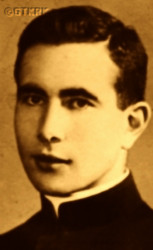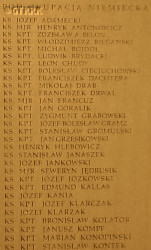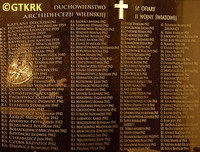Roman Catholic
St Sigismund parish
05-507 Słomczyn
85 Wiślana Str.
Konstancin deanery
Warsaw archdiocese, Poland
full list:
displayClick to display full list

searchClick to search full list by categories
wyświetlKliknij by wyświetlić pełną listę po polsku

szukajKliknij by przeszukać listę wg kategorii po polsku

Martyrology of the clergy — Poland
XX century (1914 – 1989)
personal data
surname
GRAMZ
forename(s)
Boleslav (pl. Bolesław)
forename(s)
versions/aliases
Joseph Boleslav (pl. Józef Bolesław)
function
diocesan priest
creed
Latin (Roman Catholic) Church RCmore on
en.wikipedia.org
[access: 2014.09.21]
diocese / province
Vilnius archdiocesemore on
en.wikipedia.org
[access: 2013.05.19]
RC Military Ordinariate of Polandmore on
en.wikipedia.org
[access: 2014.12.20]
academic distinctions
Sacred Theology MA
date and place
of death
08.06.1944

between Idolta and Dryssatoday: between Idolta and Verkhnyadzvinsk, Myory dist., Vitebsk reg., Belarus
more on
be.wikipedia.org
[access: 2023.01.18]
details of death
On 01.01.1939 chaplain of the Polish Army reserve.
Prob. on 24‐27.08.1939 mobilized as a chaplain of 6th Legions' Infantry Regiment part of the 1st Legions' Infantry Division.
After German and Russian invasion of Poland in 09.1939 and start of the World War II, the regiment among others recaptured in the victorious battle with the Germans Kałuszyn (11‐12.09.1939), recaptured Wola Wodzyńska (13.09.1939).
Capitulated on 25.09.1939.
Interned by the Germans.
Escaped and hid in German–occupied Warsaw — in General Governorate.
Collaborated with Polish clandestine Armed Struggle Union ZWZ, future Home Army AK (part of Polish Clandestine State).
After German attack on 22.06.1941 of their erstwhile ally, Russians, returned to the–then German–occupied Vilnius.
Nominated parish priest of Idołta parish helped persecuted Jews and Gypsies.
„Clandestinely provided shelter to the Jews, cooked large cauldrons of food for them and brought them to the basement near his rectory”.
Ministered to Poles left out beyond pre‐war Polish border — in Russia (for 20 years without ministry and access to sacraments).
Organised and clandestinely taught children — the activity strictly forbidden by the Germans — as such part of efforts of the Polish Clandestine State.
Criticized the attitude of the Lithuanian auxiliary bishop, Abp Reinys, who, in the face of the arrest of Abp Jałbrzykowski by the Germans, served as bishop ordinary of the Vilnius archdiocese and eliminated persecuted Polish priests and signs of Polishness from the diocese entrusted to him — e.g. removed from the Litany to the Mother of God the calling to the „Queen of the Polish Crown”.
Arrested on 07/08.06.1944 by Belarusian police — sanctioned by and collaborating with the Germans.
Murdered when escorted to Dryssa (40 km from Idołta) — on the way Belarusians stopped, started to drink and forced the priest to run.
During such an attempt shot him.
cause of death
murder
perpetrators
Belarusians
sites and events
Help to the JewsClick to display the description, GeneralgouvernementClick to display the description, Ribbentrop‐MolotovClick to display the description, Pius XI's encyclicalsClick to display the description
date and place
of birth
04.04.1904

Kublichitoday: Kublichi ssov., Ushachy dist., Vitebsk reg., Belarus
more on
be.wikipedia.org
[access: 2023.01.18]
presbyter (holy orders)
ordination
04.04.1931

Vilniustoday: Vilnius city dist., Vilnius Cou., Lithuania
more on
en.wikipedia.org
[access: 2022.01.06]
St Stanislav the Bishop and Martyr and St Vladislav RC cathedral churchmore on
en.wikipedia.org
[access: 2025.03.14]
positions held
1941 – 1944
parish priest — Idołtatoday: Povyate ssov., Myory dist., Vitebsk reg., Belarus
more on
be.wikipedia.org
[access: 2023.01.18] ⋄ Immaculate Conception of the Blessed Virgin Mary RC parish ⋄ Myorytoday: Myory dist., Vitebsk reg., Belarus
more on
en.wikipedia.org
[access: 2024.03.19] RC deanery
1939 – 1941
priest — Warsawtoday: Warsaw city pov., Masovia voiv., Poland
more on
en.wikipedia.org
[access: 2021.10.09]
till 1939
editor — magazines, „Open Cases”, „The World of the Dead”
till 1939
prefect — Juodšiliaitoday: Juodšiliai eld., Vilnius dist., Vilnius Cou., Lithuania
more on
en.wikipedia.org
[access: 2022.01.06] ⋄ Blessed Virgin Mary Mother of Mercy RC chapel ⋄ Rudaminatoday: Rudamina eld., Vilnius dist., Vilnius Cou., Lithuania
more on
en.wikipedia.org
[access: 2024.03.19], Our Lady of Good Councel RC parish ⋄ Turgeliaitoday: Turgeliai eld., Turgeliai dist., Vilnius Cou., Lithuania
more on
lt.wikipedia.org
[access: 2022.06.29] RC deanery — also: prefect of elementary schools in Vilnius
c. 1938
vicar — Vilniustoday: Vilnius city dist., Vilnius Cou., Lithuania
more on
en.wikipedia.org
[access: 2022.01.06] ⋄ St Francis and St Bernard RC parish ⋄ Vilniustoday: Vilnius city dist., Vilnius Cou., Lithuania
more on
en.wikipedia.org
[access: 2022.01.06] RC deanery — also: prefect of elementary schools
c. 1937
vicar — Białystoktoday: Białystok city pov., Podlaskie voiv., Poland
more on
en.wikipedia.org
[access: 2020.12.11] ⋄ Assumption of the Blessed Virgin Mary RC parish (main parish) ⋄ Białystoktoday: Białystok city pov., Podlaskie voiv., Poland
more on
en.wikipedia.org
[access: 2020.12.11] RC deanery — formal posting
1936 – 1937
prefect — Švenčionystoday: Švenčionys eld., Švenčionys dist., Vilnius Cou., Lithuania
more on
en.wikipedia.org
[access: 2020.11.13] ⋄ Joseph Piłsudski's State Gymnasium (prob.) ⋄ All the Saints RC parish ⋄ Švenčionystoday: Švenčionys eld., Švenčionys dist., Vilnius Cou., Lithuania
more on
en.wikipedia.org
[access: 2020.11.13] RC deanery
1934 – 1936
PhD student — Rometoday: Rome prov., Lazio reg., Italy
more on
en.wikipedia.org
[access: 2021.12.18] — PhD thesis „Union between the second and third partition of Poland (1793‐1795)”, finished in 1939, not defended
from 1933
vicar — Vilniustoday: Vilnius city dist., Vilnius Cou., Lithuania
more on
en.wikipedia.org
[access: 2022.01.06] ⋄ St Therese the Virgin RC parish (Gate of Dawn) ⋄ Vilniustoday: Vilnius city dist., Vilnius Cou., Lithuania
more on
en.wikipedia.org
[access: 2022.01.06] RC deanery
till 1933
vicar — Vilniustoday: Vilnius city dist., Vilnius Cou., Lithuania
more on
en.wikipedia.org
[access: 2022.01.06] ⋄ All the Saints RC parish ⋄ Vilniustoday: Vilnius city dist., Vilnius Cou., Lithuania
more on
en.wikipedia.org
[access: 2022.01.06] RC deanery
c. 1932
vicar — Ashmyanytoday: Ashmyany dist., Grodno reg., Belarus
more on
en.wikipedia.org
[access: 2020.11.27] ⋄ St Michael the Archangel RC parish ⋄ Ashmyanytoday: Ashmyany dist., Grodno reg., Belarus
more on
en.wikipedia.org
[access: 2020.11.27] RC deanery
from 1931
vicar — Grodnotoday: Grodno dist., Grodno reg., Belarus
more on
en.wikipedia.org
[access: 2023.01.18] ⋄ RC parish ⋄ Grodnotoday: Grodno dist., Grodno reg., Belarus
more on
en.wikipedia.org
[access: 2023.01.18] RC deanery
till 1931
student — Vilniustoday: Vilnius city dist., Vilnius Cou., Lithuania
more on
en.wikipedia.org
[access: 2022.01.06] ⋄ Department of Theology, Stephen Batory University [i.e. Vilnius University (from 1945) / some faculties acting clandestinely (1939‐1945) / closed by Lithuanians (1939) / Stephen Batory University (1919‐1939)] — postgraduate specialised studies crowned with the title of Master of Sacred Theology on the basis of the thesis „Eschatology of the Greeks at the Council of Ferraro–Florence”
1925 – 1931
student — Vilniustoday: Vilnius city dist., Vilnius Cou., Lithuania
more on
en.wikipedia.org
[access: 2022.01.06] ⋄ philosophy and theology, Theological Seminary
sites and events
descriptions
Help to the Jews: During World War II on the Polish occupied territories Germans forbid to give any support to the Jews under penalty of death. Hundreds of Polish priests and religious helped the Jews despite this official sanction. Many of them were caught and murdered.
Generalgouvernement: After the Polish defeat in the 09.1939 campaign, which was the result of the Ribbentrop‐Molotov Pact and constituted the first stage of World War II, and the beginning of German occupation in part of Poland (in the other, eastern part of Poland, the Russian occupation began), the Germans divided the occupied Polish territory into five main regions. In two of them new German provinces were created, two other were incorporated into other provinces. However, the fifth part was treated separately, and in a political sense it was supposed to recreate the German idea from 1915 (during World War I, after the defeat of the Russians in the Battle of Gorlice in 05.1915) of creating a Polish enclave within Germany. Illegal in the sense of international law, i.e. Hague Convention, and public law, managed by the Germans according to separate laws — especially established for the Polish Germ. Untermenschen (Eng. subhumans) — till the Russian offensive in 1945 it constituted part of the Germ. Großdeutschland (Eng. Greater Germany). Till 31.07.1940 formally called Germ. Generalgouvernement für die besetzten polnischen Gebiete (Eng. General Government for the occupied Polish lands) — later simply Germ. Generalgouvernement (Eng. General Governorate), as in the years 1915‐1918. From 07.1941, i.e. after the German attack on 22.06.1941 against the erstwhile ally, the Russians, it also included the Galicia district, i.e. the Polish pre‐war south‐eastern voivodeships. A special criminal law was enacted and applied to Poles and Jews, allowing for the arbitrary administration of the death penalty regardless of the age of the „perpetrator”, and sanctioning the use of collective responsibility. After the end of the military conflict of the World War UU, the government of the Germ. Generalgouvernement was recognized as a criminal organization, and its leader, governor Hans Frank, guilty of war crimes and crimes against humanity and executed. (more on: en.wikipedia.orgClick to attempt to display webpage
[access: 2024.12.13])
Ribbentrop‐Molotov: Genocidal Russian‐German alliance pact between Russian leader Joseph Stalin and German leader Adolf Hitler signed on 23.08.1939 in Moscow by respective foreign ministers, Mr. Vyacheslav Molotov for Russia and Joachim von Ribbentrop for Germany. The pact sanctioned and was the direct cause of joint Russian and German invasion of Poland and the outbreak of the World War II in 09.1939. In a political sense, the pact was an attempt to restore the status quo ante before 1914, with one exception, namely the „commercial” exchange of the so‐called „Kingdom of Poland”, which in 1914 was part of the Russian Empire, fore Eastern Galicia (today's western Ukraine), in 1914 belonging to the Austro‐Hungarian Empire. Galicia, including Lviv, was to be taken over by the Russians, the „Kingdom of Poland” — under the name of the General Governorate — Germany. The resultant „war was one of the greatest calamities and dramas of humanity in history, for two atheistic and anti‐Christian ideologies — national and international socialism — rejected God and His fifth Decalogue commandment: Thou shall not kill!” (Abp Stanislav Gądecki, 01.09.2019). The decisions taken — backed up by the betrayal of the formal allies of Poland, France and Germany, which on 12.09.1939, at a joint conference in Abbeville, decided not to provide aid to attacked Poland and not to take military action against Germany (a clear breach of treaty obligations with Poland) — were on 28.09.1939 slightly altered and made more precise when a treaty on „German‐Russian boundaries and friendship” was agreed by the same murderous signatories. One of its findings was establishment of spheres of influence in Central and Eastern Europe and in consequence IV partition of Poland. In one of its secret annexes agreed, that: „the Signatories will not tolerate on its respective territories any Polish propaganda that affects the territory of the other Side. On their respective territories they will suppress all such propaganda and inform each other of the measures taken to accomplish it”. The agreements resulted in a series of meeting between two genocidal organization representing both sides — German Gestapo and Russian NKVD when coordination of efforts to exterminate Polish intelligentsia and Polish leading classes (in Germany called «Intelligenzaktion», in Russia took the form of Katyń massacres) where discussed. Resulted in deaths of hundreds of thousands of Polish intelligentsia, including thousands of priests presented here, and tens of millions of ordinary people,. The results of this Russian‐German pact lasted till 1989 and are still in evidence even today. (more on: en.wikipedia.orgClick to attempt to display webpage
[access: 2015.09.30])
Pius XI's encyclicals: Facing the creation of two totalitarian systems in Europe, which seemed to compete with each other, though there were more similarities than contradictions between them, Pope Pius XI issued in 03.1937 (within 5 days) two encyclicals. In the „Mit brennender Sorge” (Eng. „With Burning Concern”) published on 14.03.1938, condemned the national socialism prevailing in Germany. The Pope wrote: „Whoever, following the old Germanic‐pre‐Christian beliefs, puts various impersonal fate in the place of a personal God, denies the wisdom of God and Providence […], whoever exalts earthly values: race or nation, or state, or state system, representatives of state power or other fundamental values of human society, […] and makes them the highest standard of all values, including religious ones, and idolizes them, this one […] is far from true faith in God and from a worldview corresponding to such faith”. On 19.03.1937, published „Divini Redemptoris” (Eng. „Divine Redeemer”), in which criticized Russian communism, dialectical materialism and the class struggle theory. The Pope wrote: „Communism deprives man of freedom, and therefore the spiritual basis of all life norms. It deprives the human person of all his dignity and any moral support with which he could resist the onslaught of blind passions […] This is the new gospel that Bolshevik and godless communism preaches as a message of salvation and redemption of humanity”… Pius XI demanded that the established human law be subjected to the natural law of God , recommended the implementation of the ideal of a Christian state and society, and called on Catholics to resist. Two years later, National Socialist Germany and Communist Russia came together and started World War II. (more on: www.vatican.vaClick to attempt to display webpage
[access: 2023.05.28], www.vatican.vaClick to attempt to display webpage
[access: 2023.05.28])
sources
personal:
www.glaukopis.plClick to attempt to display webpage
[access: 2012.11.23], www.bialystok.opoka.org.plClick to attempt to display webpage
[access: 2012.12.28]
bibliographical:
„Vilnius archdiocese clergy martyrology 1939‐1945”, Fr Thaddeus Krahel, Białystok, 2017
original images:
www.bialystok.opoka.org.plClick to attempt to display webpage
[access: 2012.12.28], www.katedrapolowa.plClick to attempt to display webpage
[access: 2014.01.16], www.ciekawepodlasie.plClick to attempt to display webpage
[access: 2020.07.31]
LETTER to CUSTODIAN/ADMINISTRATOR
If you have an Email client on your communicator/computer — such as Mozilla Thunderbird, Windows Mail or Microsoft Outlook, described at WikipediaPatrz:
en.wikipedia.org, among others — try the link below, please:
LETTER to CUSTODIAN/ADMINISTRATORClick and try to call your own Email client
If however you do not run such a client or the above link is not active please send an email to the Custodian/Administrator using your account — in your customary email/correspondence engine — at the following address:

giving the following as the subject:
MARTYROLOGY: GRAMZ Boleslav
To return to the biography press below:
 Click to return to biography
Click to return to biography











